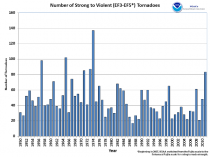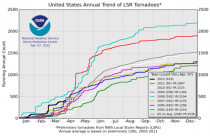Heidi Cullen and Joe Romm and the many enviro journalists predictably blamed recent tornado outbreaks in 2012 and especially 2011 on greenhouse gases. This submission is from an employee of the same company Cullen worked at who asked to remain anonymous. She often had eyes rolling with her bad science. And what can you say about Romm. Both now are employees of George Soros - which speaks volumes
I recently asked SPC for the U.S. annual list of tornado count, fatatlies, and killer tornadoes.
They sent me the list. Official records begin in 1950.
This provides a good opportunity to examine an official data set and realize they can sometimes be misleading, especially when trying to determine trends over an extended period of time.
1) There is a significant spike in annual tornado count starting in 1953. This was the year the Severe Local Storms (SELS) unit, forerunner of SPC, was established for around the clock severe storm monitoring. Tornado reporting was encouraged by the U.S. Weather Bureau for documentation and watch/warning verification purposes, hence the increase in count.
2) Starting in 1990, you see another significant spike to above 1000 in tornado count. This year marked the first installation of NEXRADs and around this time, storm chasing was beginning to ramp up in popularity. Both of these resulted in more tornadoes being reported, verified, and documented.
3) After 1990, the NWS Modernization occurred over the next several years, and investigation of tornado reports and post damage storm surveys at each new WFO country warning area ramped up considerably, leading to a more representative count of tornadoes per year, staying above 1000 for all years afterwards except 2002.
4) Storm chasing really took off after the release of the movie ‘Twister’ in 1996 and has continued to grow ever since. This continued to increase/sustain higher annual tornado counts.
5) By the middle part of the first decade of the new millennium, digital cameras were rapidly replacing traditional slide and print film. This eliminated the long processing times of film, allowing for not only more tornadoes to be verified and documented, but also in a more timely manner.
6) By the end of the first decade of the new millennium, social media such as Facebook and Twitter allowed instant reporting of tornadoes in real time. Wireless Internet had been firmly established for the now ubiquitous smartphone/mobile device, combined with built-in digital still picture and video cameras, made tornado reporting and verification even quicker and more efficient. Also, tornadoes took front and center in the mainstream media, both in the daily news and reality shows.
So all the above shows that a data set can be misleading over an extended period of time if you do not take into account changes in things like technology, population, and public awareness, as three examples. Despite all this, we still too low in the annual tornado count. By how much on average?, difficult to say, but likely by a few hundred. We document nearly all the the significant tornadoes, but smaller, short live ones are missed, due to darkness, poor visibility, and/or remoteness of location. We are finding tornadoes in the Rockies and Great Basin and more common than once thought. Given the low population density and large area, it is likely these areas of the country are
where we miss the most tornadoes.
Some other notes...you can see the number of tornado fatalities can highly vary from year to year going back to to 1950. Overall though, there has been downward trend in fatatlies long term. However, the benefits of better warnings and awareness/preparation is constantly being tempered by the growing population.
Year U.S. Population
1950 151,325,798
1960 179,323,175
1970 203,211,926
1980 226,545,805
1990 248,709,873
2000 281,421,906
2010 308,745,538
We have doubled in population in 60 years. Put simply, there are just more people in the way of tornadoes every year. In addition, population in and around the larger cities has become denser, so the potential of very high death tolls for when a large, violent tornado plows through any of the larger cities is becoming more and more likely as time goes on.
So I think this shows to a respectable, if not a large degree, tornadoes are only becoming “worse” not due to meteorological or climatological reasons, but more due to technological and sociological reasons.
In terms of strong tornadoes, despite all the bloviating by Cullen and Romm about the 2011 barages, the final numbers SPC concluded were not unprecedented but typical of the cold PDO La Ninas of the 1950s to 1970s.

Enlarged.
And the count this year even with the big March outreak which was due to very cold air aloft is in the middle of the of the last decade even before the adjustment down for multiple report of the same tornadoes.
Being we are coming off La Nina and the PDO is still negative, we WILL see more outbreaks but remember 2011 was special since it was the second strongest La Nina on record (behind 1917/18 or 1955/56 depending on measure used). It was responsible for the flooding, drought, tornadoes, hurricane and snows.





